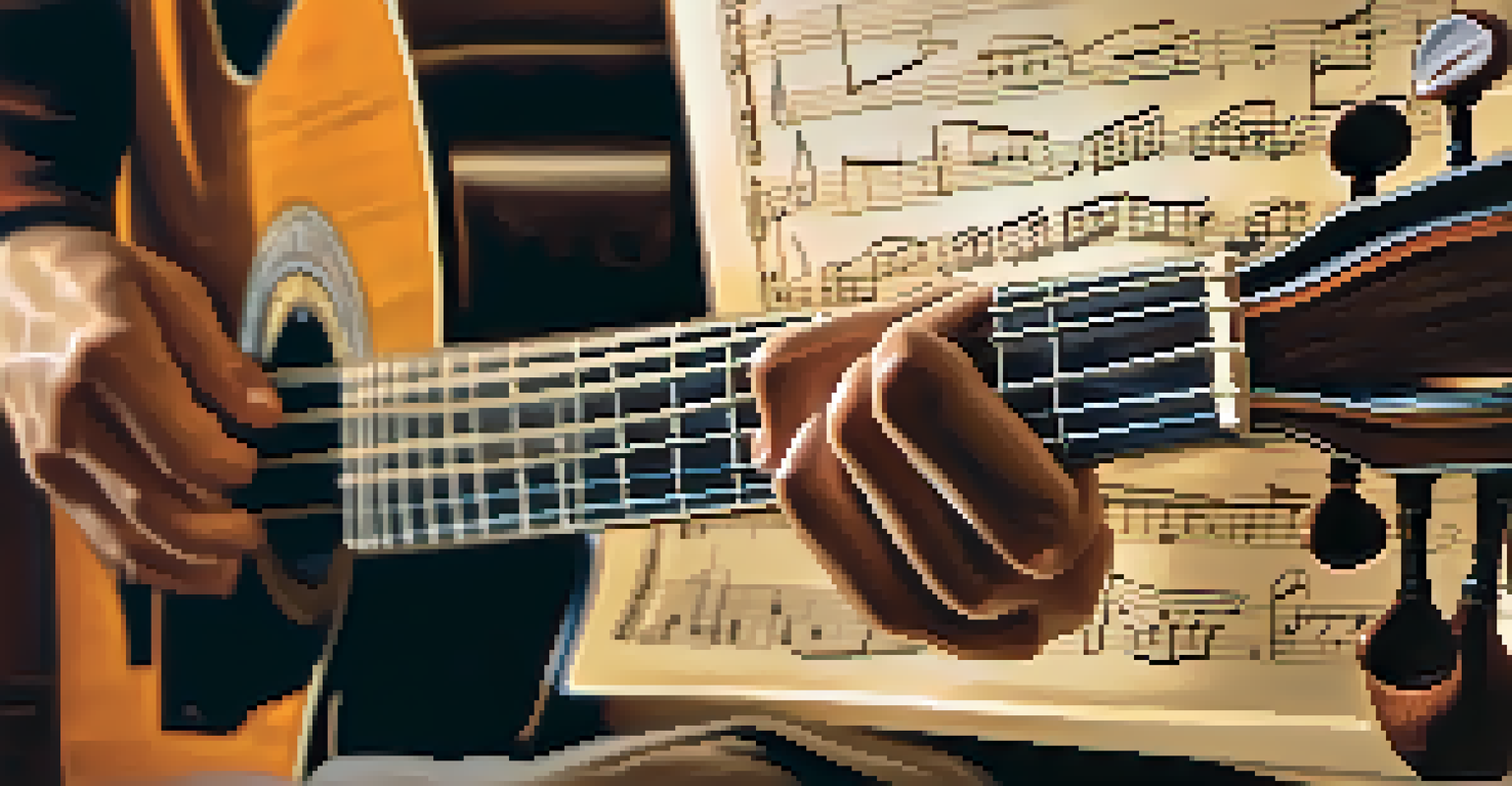Exploring the Relationship Between Scales and Chord Progressions

What Are Scales and Chord Progressions?
Scales are foundational elements in music, consisting of a series of notes arranged in ascending or descending order. They provide the building blocks for melodies and harmonies, influencing the mood and style of a piece. Chord progressions, on the other hand, are sequences of chords that accompany melodies, creating the harmonic framework of a song.
Music is the shorthand of emotion.
Think of scales as the colors on an artist's palette, while chord progressions are the brushstrokes that bring a painting to life. The choice of scale can dramatically affect how a chord progression feels, whether it evokes joy, sadness, or tension. Understanding these relationships is crucial for any musician looking to enhance their songwriting or improvisation skills.
In essence, scales and chord progressions work hand in hand to create a cohesive musical experience. By exploring how these two elements interact, musicians can unlock a deeper understanding of their craft and improve their overall musicality.
The Role of Major and Minor Scales
Major and minor scales are the most commonly used in Western music, each imparting a distinct emotional quality. Major scales tend to evoke feelings of happiness and brightness, while minor scales are often associated with sadness or introspection. This emotional palette guides musicians in selecting appropriate chord progressions to convey their intended message.

For example, a song in C major might use the chord progression C-G-Am-F, creating an uplifting and hopeful sound. In contrast, a piece in A minor could explore a progression like Am-F-C-G, which often feels more somber and contemplative. The choice between major and minor can completely transform the listener's experience.
Understanding Scales and Emotions
Scales and chord progressions work together to create emotional depth in music, influencing how listeners feel.
Understanding these differences is essential for composers and songwriters. By experimenting with major and minor scales, they can create diverse emotional landscapes, drawing listeners into their musical narratives.
Connecting Scales to Chord Functions
Each note in a scale has a specific relationship to the chords built from it, known as chord functions. These functions include tonic (the home chord), dominant (the chord that creates tension), and subdominant (the transitional chord). Recognizing these functions helps musicians craft effective chord progressions that resonate with listeners.
The music is not in the notes, but in the silence between.
For instance, in a C major scale, the tonic would be C major, the dominant G major, and the subdominant F major. These chords can be combined in various ways to create progressions that feel stable or dynamic. By understanding how each chord relates to the scale, musicians can experiment and discover unique harmonic ideas.
Ultimately, the connection between scales and chord functions enriches musical composition. This knowledge allows artists to create progressions that not only sound good but also convey deeper meanings and emotions.
Common Chord Progressions and Their Scales
Certain chord progressions have become staples in popular music, often tied closely to specific scales. For example, the I-IV-V progression (like C-F-G in C major) is ubiquitous in rock and pop, while the ii-V-I progression (Dmin-G-C in C major) is a cornerstone in jazz. Each of these progressions has its roots in the corresponding scale, shaping the overall sound.
Recognizing these patterns can inspire songwriters to create their own variations or to explore new genres. By understanding the scale that underpins a progression, musicians can experiment with different melodies while maintaining harmonic coherence. This kind of exploration often leads to exciting musical discoveries.
Major vs. Minor Scales
The choice between major and minor scales significantly impacts the emotional quality of a song, shaping its overall mood.
Additionally, these common progressions serve as a foundation for improvisation. Musicians can use their knowledge of scales to create solos that complement the chord changes, enhancing the overall performance.
Using Modes to Expand Chord Progressions
Modes are variations of scales that start on different degrees of the parent scale, offering fresh sounds and emotional depth. For example, the Dorian mode, derived from the major scale, introduces a jazzy feel, while the Mixolydian mode adds a bluesy quality. By incorporating modes into chord progressions, musicians can explore new sonic territories.
For instance, if a song is based in C major, using the D Dorian mode could lead to a chord progression like Dmin-G-C, which gives a different flavor than sticking strictly to C major. This versatility allows composers to break away from conventional progressions and create more engaging music.
Exploring modes can also enhance improvisation. Musicians can switch between modes during a performance to keep things interesting, allowing for a dynamic interplay between melody and harmony.
The Emotional Impact of Scales and Chord Progressions
Music has the unique power to evoke emotions, and the relationship between scales and chord progressions is key to this phenomenon. The choice of scale can set the emotional tone, while the chord progression shapes the journey. For example, a minor scale with a descending chord progression can create a feeling of melancholy, whereas an ascending major progression might inspire joy.
By understanding this emotional interplay, musicians can craft songs that resonate with listeners on a deeper level. They can use their knowledge of scales and progressions to tell stories, express feelings, and connect with audiences in meaningful ways. This emotional connection is what often makes a piece of music memorable.
Exploring Modes for Creativity
Using modes derived from scales can expand chord progressions, allowing musicians to create unique and engaging musical experiences.
Ultimately, the emotional impact of music is a powerful tool for artists. By mastering the relationship between scales and chord progressions, they can create works that not only sound beautiful but also touch the hearts of listeners.
Practical Tips for Musicians
For musicians looking to explore the relationship between scales and chord progressions, practice is key. Start by experimenting with different scales on your instrument, playing familiar chord progressions and noting how they change the feel of the music. This hands-on approach helps solidify your understanding of how scales influence harmony.
Another great exercise is to transcribe your favorite songs, paying attention to their scales and chord progressions. Analyze how the two elements interact and consider how you might apply similar techniques in your own compositions. This not only enhances your musical vocabulary but also inspires creativity.

Lastly, don’t shy away from collaboration. Working with other musicians can open new avenues for exploration, allowing you to hear how different scales and progressions can be used effectively. Embrace the learning process, and you'll find that the relationship between scales and chord progressions becomes second nature.